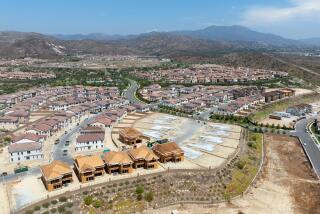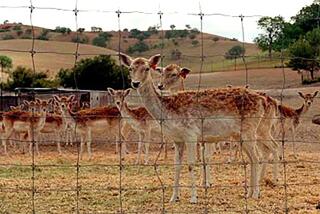EL TORO STATION : FOCUS : Semper Fi On High
- Share via
In the early days of World War II, the federal government purchased about 2,400 acres of agricultural land from the Irvine Ranch to build a military air base. Today the El Toro Marine Corps Air Station accounts for a total of 4,700 acres and is the largest subordinate air base in the western United States.
Orange County’s unincorporated area designated as El Toro Station -- headquarters of the Aircraft Bases Command of the western area -- houses a Marine Corps air station, an aircraft wing and 9,000 Marines. The station and wing schools train pilots, air crew and noncommissioned officers. Students learn tactical weapons operations, aircraft systems and leadership.
El Toro is a tactical airfield. Its mission is to maintain, operate and provide services and materials to support the Marine Aircraft Wing. It also serves the same purpose for any other units so designated by the commandant of the Marine Corps in accordance with the chief of naval operations.
Located outside the station headquarters building is a bell (El Toro’s Taoist Bell) constructed by Chinese artisans in 1628. It was taken from its home -- the village of Ho Chien, north of the Yellow River -- in 1945 by Lt. Gen. L.E. Woods. The officer salvaged the bell from a junk pile left by the Japanese. The Ho Chien mayor gave his permission for the Marines to take the bell to the United States.
A little-known distinction for the base is that the first full-time civilian fire department in Orange County was formed there. The unit was founded on St. Patrick’s Day 1943 and the Marine Corps named it after the nearby unincorporated community of El Toro.
The Navy recently awarded a $10.9 million contract to Anaheim’s Blair Paving Co. to repair and extend the station’s major runway. Work on the extension began in February and completion is expected by June 1989. The runway is now 6,300 feet long; when completed it will be 10,000 feet.
Last December Congress ordered the Federal Aviation Administration (FAA) to study the feasibility of allowing commercial cargo planes to arrive and depart from El Toro. The FAA concluded that such joint usage would be practical and would alleviate overcrowding at John Wayne Airport.
Irvine Mayor Larry Agran opposes this joint-usage idea, claiming it would create safety, noise and traffic problems on the city’s eastern border. On the other hand, residents of Newport Beach support the idea, viewing it as the only way to ease pressure at John Wayne Airport and help meet the county’s growing demand for commercial air service. For their part, the Marines unequivocally oppose joint-usage of their facility.
The base also found itself a center of attention last week, when the U.S. Environmental Protection Agency (EPA) proposed adding it to the Superfund hazardous-waste cleanup list. EPA targeted 21 areas of the base, with problems ranging from buried drums of explosives and low-level radioactive waste to water contaminated with trichloroethylene, or TCE, a cancer-causing agent used to clean grease out of aircraft engines. During the next 60 days EPA will solicit public comments and then decide whether to list the base as a Superfund site.
Statistics Population: (1987 est.) 7,339 Median household income: $16,815 Racial/ethnic mix: white, 70.6%; Latino, 13.3%; black, 15.0%; other, 13.5% (Total is more than 100% because racial/ethnic breakdowns overlap)
Employment status Employed persons: 681 Unemployed: 84 Not in labor force: 610 Per capita income: $3,598
Education Adults over 25 Years of school completed: 0-11 years: 11.3% 12 years: 49.3% 13-15 years: 26.3% 16+ years: 13.2% Median years completed: 12.7
Population Median Age: 20.5 years
Statistics: Donnelley Demographics
More to Read
Sign up for Essential California
The most important California stories and recommendations in your inbox every morning.
You may occasionally receive promotional content from the Los Angeles Times.













